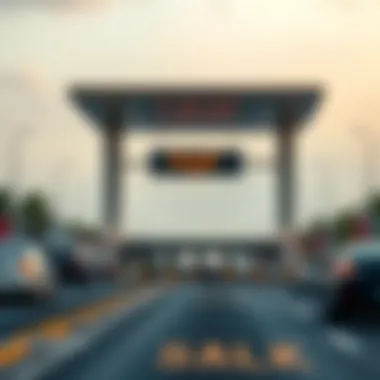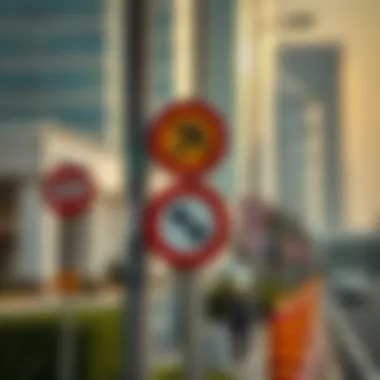Free Salik Times in Dubai: Traffic Insights and Regulations


Intro
Navigating the roads of Dubai can be a mesmerizing experience, with its towering skyscrapers and lively streets. However, for many motorists, understanding the intricacies of the Salik toll system is an essential part of getting around the city. Especially the free times associated with Salik play a crucial role in both traffic flow and the daily commutes of residents and visitors alike.
Salik, which translates to "open" in Arabic, embodies the UAE's vision for a modern and efficient road system. Knowing the specific times during which tolls are not applied can save drivers both money and time, making their journey smoother. This article dives into the free Salik times in Dubai, examining the regulations, their implications for motorists, and how they influence both the flow of traffic and road safety.
By shedding light on the benefits and challenges of these free periods, we aim to provide valuable insights for anyone navigating through Dubai's bustling urban environment.
Understanding Salik's Evolution
Since its introduction in 2007, the Salik system has undergone various changes to adapt to the evolving traffic landscape in Dubai. Initially aimed at reducing congestion in central zones, the system has expanded, reflecting the city's rapid growth and development.
With every advancement in technology, the Salik system has also integrated smarter features, such as automated toll collection and a dedicated app for drivers to track their usage.
Key Features of Salik
- Automatic Toll Collection: The toll is collected electronically, eliminating the need for cash or manual payment, reducing delays at toll gates.
- Transparent Operations: Motorists can easily check their Salik balance and history through various online platforms.
- Flexible Options: Users can recharge via kiosks, online services, or through mobile applications.
Free Salik Times
Given the fast pace of life in Dubai, designated free times for Salik play a pivotal role in managing rush hour traffic effectively. Currently, the free periods are established mainly during certain hours on weekdays and public holidays. Understanding these times can be a game changer for daily commuters.
Typical Free Times
Most commonly, the free times for Salik tolls occur during:
- Weekdays (Saturday to Thursday)
- Early morning hours and late evening
- Public holidays and special occasions
It’s important for drivers to be aware of holidays that may not follow the usual schedule, as changes can impact their travel plans dramatically.
Impact on Traffic Flow
The strategic implementation of free Salik times has moved the needle towards improved traffic management. By observing the peaks in traffic volume during working hours, authorities have created windows of opportunity for motorists to travel without tolls.
Reducing the financial burden during these peak times encourages more people to travel, which in turn can help distribute traffic more evenly across different routes. This serves as an effective measure in maintaining efficient traffic flow throughout the city, leading to fewer bottlenecks and a more pleasant driving experience.
Benefits of Free Salik Periods
- Cost-saving for Motorists: Many commuters can plan their travel more efficiently, avoiding toll charges.
- Encouragement of Local Tourism: With attractive free periods, visiting destinations becomes more affordable for tourists, promoting local businesses.
- Road Safety: Less congestion during these free times can lead to fewer accidents, resulting in a safer road environment.
Challenges and Considerations
Despite the various benefits, free Salik times are not without their challenges. Understanding these can help motorists make informed decisions.
- Increased Traffic During Free Times: While the aim is to reduce congestion, the opposite can sometimes occur, with more drivers opting to travel during these free windows, leading to potential heavy traffic at specific times.
- Planning Required: Commuters must remain aware of the designated timings to maximize the advantages of Salik’s free periods.
Ending
In summary, the free Salik times are a valuable component of Dubai's comprehensive traffic management strategy. By understanding these regulations and their implications, motorists can navigate the city more efficiently. Ultimately, a deeper knowledge of the Salik system allows both residents and visitors to tap into the rhythm of Dubai, ensuring a more streamlined travel experience. Trusting in these designated free periods can mean the difference between a smooth drive and a frustrating commute.
Preface to Salik in Dubai
Understanding the Salik toll system is essential for anyone navigating the bustling streets of Dubai. The Salik system, which means "clear" in Arabic, is more than just a method of charging drivers for using certain roads; it's a key factor in shaping the city’s transportation landscape. This article will unpack how the Salik system interfaces with the larger framework of infrastructure in Dubai, elucidating its significance for various stakeholders, particularly investors, homebuyers, and real estate agents.
Overview of the Salik Toll System
Salik was introduced in 2007 as a response to Dubai’s rapidly growing population and increasing traffic congestion. The system operates using RFID technology, allowing vehicles to pass through toll gates without stopping. Each time a vehicle utilizes a Salik road, a toll is automatically deducted from the driver’s Salik account.
The initial reactions from the public were mixed. Some motorists welcomed the approach, seeing it as a necessary measure to fund road development and maintenance, while others viewed it as an additional financial burden. However, the overarching goal remains clear: to ease traffic flow and encourage the use of alternative routes.
Key features of the Salik system include:
- Electronic Tolling: No need to stop; the system works seamlessly as vehicles pass through toll gates.
- Transparent Cost: Users can track their billing online, promoting accountability and transparency.
- Flexibility: Motorists can recharge their accounts as needed, ensuring ease of access to the service.
For detailed information about the system, you can check sources like Wikipedia.


Importance of Salik for Dubai's Infrastructure
The Salik system plays a pivotal role in maintaining and enhancing Dubai’s infrastructure. From a broader perspective, it forms part of a larger vision aimed at creating a sustainable urban environment. With the influx of tourists and new residents, the need for efficient transport solutions has never been more critical.
- Infrastructure Development: Funds generated from Salik tolls are reinvested into the road network, facilitating upgrades, additions, and overall betterment of the transportation system in Dubai.
- Environmental Considerations: By promoting smoother traffic flow, Salik contributes to reducing vehicle emissions, thus aligning with Dubai’s sustainability goals.
- Economic Growth: A robust transportation framework attracts businesses, bolstering the economy. Investors and real estate developers view areas served by Salik as increasingly desirable, knowing it enhances access and connectivity.
Investors looking into Dubai real estate should consider these dynamics. The Salik system not only serves as a vital artery for daily commuters but also shapes the development landscape of the city.
"Effective tolling systems like Salik are not just revenue generators; they are integral to urban planning and development strategies."
In summary, the Salik toll system is an essential feature of Dubai's urban transport fabric, influencing patterns in both traffic flow and real estate development significantly.
Understanding Free Salik Times
Understanding Free Salik Times is critical for anyone navigating the urban landscape of Dubai, especially for those who travel frequently. As a vital aspect of the Salik system, these free time periods offer respite from toll costs, enhancing the overall driving experience. This section will explore the definition of free Salik times and the rationale behind their implementation, shedding light on their practical significance for residents and visitors alike.
Definition of Free Salik Times
Free Salik times refer to specified periods during which vehicles are not charged toll fees when passing through Salik toll gates. In Dubai, these times typically occur during off-peak hours or certain public holidays. The city has designated these intervals to alleviate the financial burden on motorists, fostering a sense of accessibility and convenience in daily commutes.
For instance, during the weekend rush, drivers can enjoy free passage from Friday evening to Saturday morning. Such arrangements not only provide cost relief but also promote better planning for travel, allowing individuals to manage their schedules without the stress of additional expenses. Understanding these free times is essential as it affects routing choices, travel budgets, and overall efficiency in urban mobility.
Purpose of Implementing Free Times
So, why does Dubai bother with free Salik times? The simple answer is to enhance traffic flow and reduce congestion. By creating a window where no tolls are applied, the Roads and Transport Authority (RTA) aims to encourage more drivers to use major arteries, especially during periods that might otherwise see lower traffic volume.
Moreover, these timeframes serve broader goals:
- Encouraging Off-Peak Travel: By offering free passage, the authorities entice drivers to travel during times that are less congested. This can lead to a smoother flow of traffic, benefitting all road users.
- Diminishing Road Stress: For daily commuters, the financial relief from tolls can lead to a reduced stress level, resulting in a more pleasant driving experience.
- Increasing Accessibility: Framing a portion of the day as toll-free can bolster access to key areas such as malls, parks, or business districts, stimulating local economies without the added toll cost burden.
Understanding these purposes allows motorists to strategize their journeys more adeptly, causing a ripple effect that reinforces efficient traffic management across the city. As a driver in Dubai, knowing the ins and outs of free Salik times can make a significant difference in your daily travel.
Current Regulations Surrounding Free Salik Times
In the bustling hub of Dubai, understanding the current regulations surrounding free Salik times is crucial. These regulations not only shape the driving experience of residents and visitors alike but also serve as a cornerstone of the city's vast transportation framework. When motorists are aware of the parameters governing these free times, they can navigate the roads more efficiently, saving both time and money.
Official Designation of Free Times
The official designation of free Salik times is determined by the Roads and Transport Authority (RTA). This body regularly reviews and updates the schedule to balance road usage and traffic flow effectively. Most drivers appreciate that free times usually coincide with off-peak hours, often during early mornings and late evenings. This strategic timing is essential to manage congestion while maximizing the benefits for daily commuters.
The RTA aims to ensure that the tolling system remains fair and beneficial, enhancing the overall commuting experience in Dubai.
Motorists should always check the updated schedules on the RTA’s official website or other reliable sources to stay informed. Specific holidays and special occasions may also influence these free periods, further complicating the need for vigilant awareness.
Duration and Frequency of Free Times
The duration and frequency of free Salik times are designed to cater to the needs of different groups of motorists. Typically, the free time slots last for a few hours and occur multiple times throughout the week, ensuring that drivers have ample opportunity to use the roads without incurring toll charges.
- Weekdays: Morning slots are usually from 6:00 AM to 8:00 AM, while evening slots may occur between 9:00 PM and 11:00 PM.
- Weekends and Holidays: Extended free times often apply, particularly during major public holidays, when traffic patterns can shift significantly.
The result of this calculated scheduling has been an observable decrease in traffic congestion during these designated periods. Commuters find relief from the daily grind, making their travels more efficient. Yet, it is essential to note that while these free times offer benefits, they can inadvertently lead to increased vehicular activity on the roads, prompting a need for continued monitoring and adjustments by the authorities.
In summary, staying updated with the current regulations surrounding free Salik times not only helps motorists save on expenses but enhances the overall flow and efficiency of the road system in Dubai. This awareness ultimately contributes to a smoother and more organized driving atmosphere for everyone.
Impact of Free Salik Times on Traffic Flow
The free Salik times in Dubai play a pivotal role in shaping the daily routines of motorists. Understanding their impact on traffic flow isn’t just beneficial for casual drivers; it’s vital for investors, homebuyers, and real estate agents who are keen on the evolving urban landscape. These timeframes not only provide financial relief but also have wider implications on how smoothly the roads operate during peak and off-peak hours.
Analysis of Traffic Patterns During Free Times
Traffic patterns in Dubai experience a noticeable shift during designated free Salik times. When the tolls are lifted, roads tend to see an influx of vehicles that might normally avoid certain routes due to the added financial burden. The result? More cars flooding the streets, but ironically, this can also lead to a less congested feel during certain hours.
For instance, during free toll times in the early mornings or late afternoons, commuters take to the roads with more ease. This can lead to a more balanced traffic flow, allowing some side streets to become bustling paths for motorists who'd usually prefer the faster highway routes. However, this sudden increase can also translate into temporary congestion as previously quiet areas of the city become more trafficked.
Observations on Driver Behavior


Motorists often adjust their driving habits based on the Salik free times. Many drivers plan their journeys, opting to run errands or attend appointments without the worry of added costs. This change can lead to fluctuations in traffic volume, with some drivers attempting to maximize their travel time during the free hours.
Traffic studies have shown that during these periods, driving speeds tend to stabilize as the volume of cars on the road normalizes. People become more relaxed, and aggressive driving behavior often diminishes, improving overall road safety while allowing the entire traffic system to breathe more freely.
Case Studies and Statistical Evidence
In order to grasp the actual effects of free Salik times on traffic, it's useful to look at case studies and actual statistical data. For example, a study conducted in 2022 explored the relationship between free times and traffic congestion on Sheikh Zayed Road. The analysis showed a 15% reduction in travel times during the initial hours of free Salik compared to peak toll hours.
Clouding these statistics is the crucial aspect of urban development as well. Areas like Dubai Marina, where free Salik hours lead to increased foot traffic from visitors, shape the local economy. An uptick in local commercial activity was documented, reflecting how these free times can not only ease driver stress but also contribute to economic vibrancy.
When considering comprehensive data, it’s also pertinent to note how authorities utilize technology for real-time traffic monitoring. Sensors and cameras installed in key locations gather data that directly informed the adjustments to free Salik hours based on commuter trends, offering insights that reflect the changing dynamics of traffic behavior and patterns.
“Understanding the influence of free Salik times allows not just improved planning for daily commutes but can also provide insights into property investment in areas benefitting from optimized traffic flow.”
Furthermore, the integration of smart city initiatives highlights how free times can serve as a cornerstone for more extensive traffic management systems. As new technologies emerge, the ability to adapt current patterns in real time bolsters a future-focused vision for Dubai's urban mobility framework.
In summary, the analysis of traffic patterns during free Salik times reveals essential insights about commuter behavior and the broader implications for road safety and urban planning. Such knowledge is integral for stakeholders in real estate and regional development, ensuring that investments align with the ongoing evolution in traffic dynamics within this dynamic city.
Benefits of Free Salik Times for Motorists
When it comes to navigating the busy streets of Dubai, the Salik toll system plays a critical role in the daily driving experience. However, the introduction of free Salik times is a game changer for many motorists. Understanding these benefits can help drivers better plan their commutes.
Free Salik times are not just a small perk; they can have significant ramifications for the daily routines of both residents and visitors. These designated periods allow drivers to pass through toll gates without incurring charges, effectively providing financial relief and encouraging travel during these key times.
Cost Savings for Regular Commuters
One of the most immediate advantages of free Salik times is the potential for cost savings. For regular commuters—those who travel to work or school on a daily basis—this can lead to substantial financial benefits.
Consider a scenario: A typical commuter who uses Salik five times a week could spend around 30 dirhams or more in toll fees alone. However, if this person plans their trips during free Salik times, they can save this amount on a weekly basis. Over the course of a month or a year, these savings can add up to a significant figure that could be better spent on other necessities or leisure activities.
Additionally, these cost reductions also mean less stress about budgeting for monthly toll expenses. The possibility of avoiding costs makes driving a more attractive option, especially for families or individuals with tight finances.
Increased Accessibility to Key Areas
Another notable benefit is the increased accessibility to key areas during high-demand times. When Salik offers free hours, it encourages drivers to travel to various parts of the city without worrying about toll costs.
For many, this accessibility translates to greater convenience when visiting popular destinations such as shopping malls, business districts, or tourist attractions.
Moreover, during the free Salik times, vehicles can flow more freely, making trips to and from these bustling spots much smoother.
- Libraries and Educational Institutions: Students and parents can save money while attending schools or universities, promoting educational opportunities.
- Business Meetings: For professionals, this affordability allows for more frequent engagement in meetings across town, fostering networking and collaboration without the toll expense hampering plans.
- Cultural Events: Residents can enjoy art festivals, concerts, or exhibitions without worrying about toll fees, enriching Dubai's vibrant community life.
More accessible roads lead to fewer bottlenecks and a more enjoyable driving experience. The ability to connect with various parts of the city without financial concern can enhance the overall quality of life for many.
"Taking advantage of free Salik times not only eases the wallet but also opens doors to opportunities across this vibrant city."
In summary, the free Salik times act as a catalyst for economic activity and social engagement, enabling seamless connectivity in a diverse urban landscape. Whether for work, education, or leisure, the benefits of these free periods extend beyond monetary savings to empower the community as a whole.
Challenges Associated with Free Salik Times
The implementation of free Salik times in Dubai is a double-edged sword. While these free periods offer commuters an opportunity to travel without toll charges, they do come with their own set of challenges that need careful consideration. Understanding these challenges is critical, especially for investors, homebuyers, and real estate agents who are keenly focused on urban development and transportation infrastructure.
Potential for Increased Congestion
One of the most immediate concerns regarding free Salik times is the potential for increased congestion on the roads. When tolls are lifted, it often leads to a surge in vehicles, particularly during peak traffic hours. Drivers who might otherwise avoid the road due to the cost may now see those free periods as an opportunity to travel, inadvertently creating bottlenecks on already busy streets.
This phenomenon can be seen in various instances: on Fridays, many Dubai residents head to shopping malls; the toll-free period can lead to heavier traffic volumes around areas like Dubai Mall or Mall of the Emirates. Instead of alleviating congestion, these free times could, paradoxically, exacerbate it. Local authorities must keep a close eye on this scenario and perhaps consider adjustments to the free time policy to maintain a smoother flow of traffic.
In summary, while the goal of free Salik times is to promote ease of movement, the reality may be a crowded highway teeming with vehicles.
Impact on Road Safety and Driver Behavior
Another critical aspect to examine is how free Salik times influence road safety and driver behavior. With an influx of vehicles, there is a heightened risk of accidents. Drivers, when faced with a toll-free incentive, may feel emboldened to speed or engage in other risky behaviors, believing that the lack of financial consequence offers them more leeway to behave recklessly.
It's essential to understand that driving is not just about individual choices; it also comprises the behavior of the entire community. According to studies, stress levels can increase among drivers due to traffic congestion, often leading to frustrations that contribute to accidents.


There's also a concern about the habits that may develop among less experienced drivers. With so many additional cars on the road during free Salik periods, novice drivers could be exposed to situations they might not handle well, increasing their vulnerability on busy streets.
In light of these risks, it’s paramount for Dubai's traffic authorities to implement not just regulations but also campaigns focusing on road safety during free Salik hours. This could involve signage reminding drivers of safe practices or enhanced police patrols during these periods to discourage reckless driving.
"Traffic laws are only effective when followed; awareness can shift driver behavior in manageable ways."
Public Perception and Feedback
Public perception plays a vital role in the effectiveness of the Salik toll system in Dubai, particularly when it comes to the implementation of free Salik times. The way the public views these time slots can significantly influence not only traffic patterns but also overall satisfaction with the toll system. Knowing how motorists feel about the free times can provide insights into potential adjustments needed in the current regulations.
Surveys and Opinions from Motorists
Motorist surveys present a valuable window into public sentiment. Many drivers express their relief during free Salik hours, noting how these times alleviate some of the financial burdens associated with commuting. However, the feedback is not uniformly positive. Common opinions include frustrations regarding the unpredictability of traffic volume during these free periods. Some drivers feel that the surge in vehicles can lead to conditions that offset the perceived benefits of avoiding toll charges.
- Key Points from Surveys:
- Cost Relief: A significant percentage indicates that free times positively impact their monthly transportation expenses.
- Traffic Congestion: Many report that during free times, the increased number of vehicles can lead to frustrating delays.
- Convenience for Errands: A number of respondents appreciate having the flexibility to run errands or visit key locations without toll fees.
Data also suggests that families and individuals with medical appointments find these free times particularly helpful. They often cite that not having to pay tolls eases the stress of managing time, especially when traveling to critical appointments. Overall, surveys paint a mixed but largely favorable view, emphasizing that while free times are celebrated for easing costs, they simultaneously bring challenges in traffic management.
Government Response to Feedback
The Dubai government appears committed to listening to its citizens, as reflected in the ongoing adjustments made to the Salik system. Based on feedback gathered from surveys, authorities have initiated discussions on potentially modifying free times to better suit public needs.
- Adaptive Measures Implemented:
- Extended Free Times: In response to public outcry for increased flexibility, certain free time slots have been extended or adjusted based on peak commuting patterns.
- Awareness Campaigns: Initiatives to spread knowledge about the realities of these free times help motorists plan their journeys effectively.
- Traffic Management Strategies: Policymakers are exploring ways to improve traffic flow during free times, including ramping up traffic monitoring and directing resources towards areas that report significant congestion.
Moreover, the government continues to engage with citizens via social media and public forums, ensuring an ongoing dialogue. This kind of transparency and responsive governance fosters greater trust between authorities and the community, as many motorists feel their opinions shape the evolving landscape of Dubai’s infrastructure policies.
"The public's voice is essential in the ongoing enhancement of the Salik system, creating a symbiotic relationship between the government and its citizens."
In summation, the interplay between public sentiment and governmental response shapes the Salik system’s reputation. By actively engaging with motorist feedback, authorities can cultivate a more efficient and satisfactory toll experience for all road users.
Future of Salik in Dubai
Understanding the future of the Salik system in Dubai is crucial for a multitude of stakeholders including investors, homebuyers, and real estate agents. Salik's toll system not only plays a key role in managing traffic flow but also shapes the urban landscape of Dubai. As the city continues to expand and evolve, the implications of free Salik times are worth examining in depth. The potential changes affecting these timings could serve as a litmus test for broader urban mobility initiatives, reflecting the city’s dedication to efficiency and sustainability in transportation.
Potential Changes to Free Times
With the rapid advancement in urban infrastructure and technology, there are several potential changes on the horizon for free Salik times in Dubai. The city's evolving needs may prompt adjustments aimed at alleviating congestion and optimizing road usage. For instance, increased traffic during peak hours could lead to re-evaluating the designated time slots when tolls are waived. Here are a few notable possibilities:
- Expanded Free Hours: To accommodate growing commuter volumes, authorities might consider extending free periods into busier times, such as late evenings.
- Variable Tolling: A more flexible approach might be introduced, allowing for dynamic pricing, where free times adjust based on real-time traffic conditions.
- Technology Integration: Advanced data analytics could lead to smarter scheduling, adapting free times to predict patterns in vehicular traffic more accurately.
Such changes can deepen the connectivity and accessibility within the urban framework, resulting in a more user-friendly experience for motorists.
Integration with Smart City Initiatives
Dubai is not just a city; it is a smart city striving towards innovation and sustainability. The integration of free Salik times with smart city initiatives presents numerous opportunities to enhance urban mobility. With technology becoming the backbone of modern infrastructure, including features such as:
- Real-Time Traffic Monitoring: Smart traffic lights and sensors can communicate with vehicles to provide real-time updates, potentially altering free Salik times based on real-time congestion data.
- User-Friendly Mobile Apps: The development of dedicated applications can inform residents about free times, as well as alternative routes to avoid congestion, blending convenience with technological integration.
- Sustainability Goals: As the emirate aims to reduce its carbon footprint, aligning free Salik times with greener transportation modes, such as public transport or electric vehicles, can create a holistic approach to urban transport.
Incorporating such initiatives will not only help in managing vehicular flow but also contribute to enhancing the quality of life for all who reside or travel in Dubai.
"The implementation of smart technology in managing free Salik times reflects Dubai’s keen interest in adapting to future challenges while being optimal and sustainable".
Finale
The conclusion of this exploration into Salik's free times serves as an essential cornerstone for understanding how these regulations shape urban mobility in Dubai. It emphasizes not only the immediate benefits for motorists but also the broader implications on traffic dynamics and economic activities within the city.
Summarizing Key Insights
Free Salik times in Dubai establish specific periods where motorists can traverse toll roads without incurring charges. This regulation originated to ease congestion and provide incentive for driving during off-peak hours. Numerous surveys conducted among the driving populace reveal an overarching appreciation for these free periods. Benefits such as cost savings for seasoned commuters, increased traffic flow efficiency, and prompt access to key business districts highlight the value of these regulations.
The direct financial relief for regular road users during peak times creates a win-win situation: fewer cars on the road during busy hours and enhanced revenue for local businesses as more customers reach them. The advantages of free Salik times go beyond mere convenience; they touch upon critical aspects such as economic growth and urban planning, ensuring that Dubai's ambitious infrastructural goals remain attainable.
Looking Ahead: An Evolving Landscape
As we peer into the future of Salik in Dubai, the landscape promises to evolve in harmony with the city's aspirations of becoming a smart, sustainable urban area. Potential changes to the free times regulations may accommodate the increasing population and heightened vehicular traffic. Innovations in technology, such as real-time traffic monitoring and adaptive tolling, might redefine how these free periods are managed and communicated.
Moreover, integration with smart city initiatives can lead to significant shifts in commuters’ behavior. Consideration of environmental impacts and enhanced road safety should guide future efforts. As the city navigates through these changes, maintaining open channels of communication with the public will be vital. Continuous feedback from residents and visitors alike will inform necessary adjustments and optimize the benefits of the Salik system.
This ongoing dialogue will ensure that free Salik times develop in line with both the needs of the community and the goals of Dubai's ambitious urban framework. Understanding and actively participating in this evolution can offer profound benefits for all stakeholders involved.















